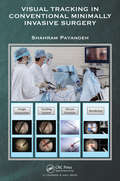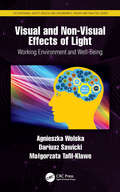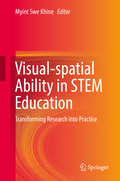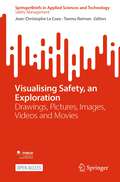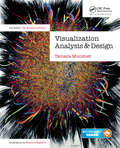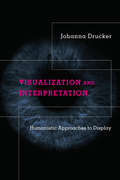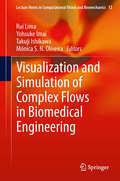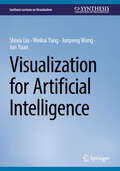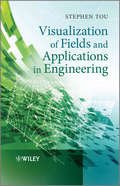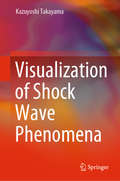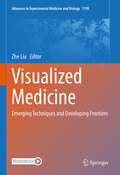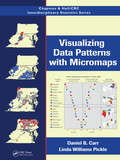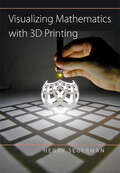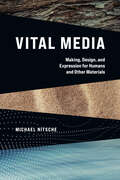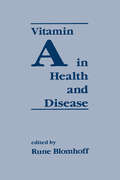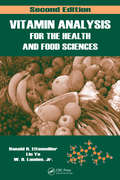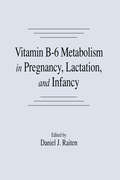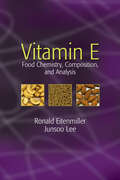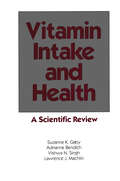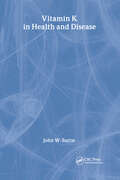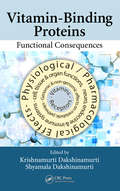- Table View
- List View
Visual Tracking in Conventional Minimally Invasive Surgery
by Shahram PayandehVisual Tracking in Conventional Minimally Invasive Surgery introduces the various tools and methodologies that can be used to enhance a conventional surgical setup with some degree of automation. The main focus of this book is on methods for tracking surgical tools and how they can be used to assist the surgeon during the surgical operation. Various notions associated with surgeon–computer interfaces and image-guided navigation are explored, with a range of experimental results. The book starts with some basic motivations for minimally invasive surgery and states the various distinctions between robotic and non-robotic (conventional) versions of this procedure. Common components of this type of operation are presented with a review of the literature addressing the automation aspects of such a setup. Examples of tracking results are shown for both motion and gesture recognition of surgical tools, which can be used as part of the surgeon–computer interface. In the case of marker-less tracking, where no special visual markers can be added to the surgical tools, the tracking results are divided into two types of methodology, depending on the nature and the estimate of the visual noise. Details of the tracking methods are presented using standard Kalman filters and particle filters. The last part of the book provides approaches for tracking a region on the surgical scene defined by the surgeon. Examples of how these tracking approaches can be used as part of image-guided navigation are demonstrated. This book is designed for control engineers interested in visual tracking, computer vision researchers and system designers involved with surgical automation, as well as surgeons, biomedical engineers, and robotic researchers.
Visual and Non-Visual Effects of Light: Working Environment and Well-Being (Occupational Safety, Health, and Ergonomics)
by Agnieszka Wolska Dariusz Sawicki Malgorzata Tafil-KlaweThe introduction of artificial lighting extends the time of wakefulness after dark and enables work at night, thus disturbing the human circadian rhythm. The understanding of the physiological mechanisms of visual and non-visual systems may be important for the development and use of proper light infrastructure and light interventions for different workplace settings, especially for shift work conditions. Visual and Non-Visual Effects of Light: Working Environment and Well-Being presents the impact of lighting in the working environment on human health, well-being and visual performance. The physiological explanation of the visual and non-visual effects of light on humans which discusses the biological bases of image and non-image forming vision at the cellular level may be of particular interest to any professional in the field of medicine, physiology, and biology. It is one of the intentions of this book to put forward some recommendations and examples of lighting design which take into account both the visual and non-visual effects of light on humans. These may be of particular interest to any professional in the field of lighting, occupational safety and health, and interior design. "What effects on health can a light ‘overdose’ or light deficiency have? What is bad light? The authors of the monograph provide answers to these questions. Just as for a physicist, the dual nature of light comprises an electromagnetic wave and a photon, the duality of light for a physician comprises visual and non-visual effects." --------------------------------------------------------Prof Jacek Przybylski, Medical University of Warsaw "This is a unique publication in the field of lighting technology. The authors have skillfully combined both the technical and biomedical aspects involved, which is unprecedented in the literature available. As a result, an important study has been created for many professional groups, with a significant impact on the assessment of risks associated with LED sources." --------------------------------------------Prof Andrzej Zając, Military University of Technology, Warsaw
Visual-spatial Ability in STEM Education
by Myint Swe KhineEach chapter in this book makes a unique contribution to the body of the literature and enhances the understanding of spatial ability and its influence on learning in the STEM disciplines. It addresses spatial abilities, ways to measure them as well as their impact and how they can affect learning subjects in scientific, technology and engineering domains. The volume deliberately covers a wide range perspectives from cognitive psychology, educational psychology, science, technology, engineering and mathematics, computer science, information technology disciplines to human development. Taking a broad view on the topic, chapters in the book discuss how to define spatial ability and its factors, the measurement of spatial ability and psychometric analyses, and educational strategies to improve spatial skills and their implications for science and technology education. The book thus provides an overview of current thinking about visual-spatial ability, spatial reasoning, and spatial skills.
Visualising Safety, an Exploration: Drawings, Pictures, Images, Videos and Movies (SpringerBriefs in Applied Sciences and Technology)
by Jean-Christophe Le Coze Teemu ReimanThis open access book explores the role visual tools and graphical models play in safety management. It explains the importance of visualising safety, for teaching concepts, communicating ideas to peers, and raising awareness of potential threats through posters. Visualising Safety, an Exploration introduces graphical models which have been influential in promoting ideas of safety, and impacting the organisational design of safety mechanisms, including the Heinreich ‘safety pyramid’ and Reason’s ‘Swiss Cheese’. It analyses these models, as well as other forms of visualization, presenting viewpoints from academics and practitioners in the fields of safety science, history, ethnography and interface design.This brief will be of interest to anyone working in the field of safety management and design, including researchers, managers and students.
Visualization Analysis and Design (Ak Peters Visualization Ser.)
by Tamara MunznerLearn How to Design Effective Visualization SystemsVisualization Analysis and Design provides a systematic, comprehensive framework for thinking about visualization in terms of principles and design choices. The book features a unified approach encompassing information visualization techniques for abstract data, scientific visualization techniques
Visualization and Interpretation: Humanistic Approaches to Display
by Johanna DruckerAn analysis of visual epistemology in the digital humanities, reorienting the creation of digital tools within humanities contexts.In the several decades since humanists have taken up computational tools, they have borrowed many techniques from other fields, including visualization methods to create charts, graphs, diagrams, maps, and other graphic displays of information. But are these visualizations actually adequate for the interpretative approach that distinguishes much of the work in the humanities? Information visualization, as practiced today, lacks the interpretivist frameworks required for humanities-oriented methodologies. In this book, Johanna Drucker continues her interrogation of visual epistemology in the digital humanities, reorienting the creation of digital tools within humanities contexts.
Visualization and Simulation of Complex Flows in Biomedical Engineering
by Rui Lima Yohsuke Imai Takuji Ishikawa Mónica S. N. OliveiraThis book focuses on the most recent advances in the application of visualization and simulation methods to understand the flow behavior of complex fluids used in biomedical engineering and other related fields. It shows the physiological flow behavior in large arteries, microcirculation, respiratory systems and in biomedical microdevices.
Visualization for Artificial Intelligence (Synthesis Lectures on Visualization)
by Jun Yuan Shixia Liu Weikai Yang Junpeng WangThis book explores how visualization provides an effective way of improving not only the interpretability but also the generalization capabilities of machine learning models. It shows how visualization can bridge the gap between complex models or algorithms and human understanding while also facilitating data curation and model refinement. Therefore, visualization for artificial intelligence (VIS4AI) has become an emerging area that combines interactive visualization with machine learning techniques to maximize their values. VIS4AI techniques focus on every phase of the machine learning life cycle, from data preprocessing to model development and deployment. These techniques are closely aligned with the well-established data and model pipelines in machine learning. In the data pipeline, they contribute to improving data quality and feature quality, including training data cleaning and feature engineering. In the model pipeline, they support (1) model development by focusing on model understanding, diagnosis, and steering; and (2) model deployment by enabling decision explanation, model performance monitoring, and model maintenance. This book provides a framework of VIS4AI and introduces the associated techniques in the two pipelines. It emphasizes the importance of interactive visualization in AI and presents various visualization techniques for different purposes. It also discusses the challenges and opportunities of VIS4AI and proposes several promising research topics for future work, such as improving training data using complementary modalities, online training diagnosis, fitting the dynamic nature of AI systems, and interactively pre-training and adapting foundation models. Overall, this book aims to serve as a resource for researchers and practitioners interested in both visualization and artificial intelligence.
Visualization in Landscape and Environmental Planning: Technology and Applications
by Ian D. Bishop Eckart LangeThis major reference presents the challenges, issues and directions of computer-based visualization of the natural and built environment and the role of such visualization in landscape and environmental planning. It offers a uniquely systematic approach to the potential of visualization and the writers are acknowledged experts in their field of specialization. Case studies are presented to illustrate many aspects of landscape management including forestry, agriculture, ecology, mining and urban development.
Visualization of Fields and Applications in Engineering
by Stephen TouDriven by advances in computer technology, engineering analysis has developed rapidly and extensively in recent times; Visualization of Fields and Applications in Engineering presents the basic techniques for tensor field visualization and mapping of engineering data. Focusing on the fundamental aspects of post processing databases and applications outputs, the author explores existing theories and their integration in tensor field visualization and analysis. The subject covers fundamental theories through to integrated, multi-disciplinary technologies with practical applications in engineering, computer /general sciences. Visualization of Fields and Applications in Engineering is suitable for academic use and to serve as a source of reference. It will appeal to those who work in the engineering and science professions or in pursuit of academic training/ research.Offers a unique engineering approach to basic techniques for tensor field visualization and mappingCollates together material currently disseminated throughout the literature into one accessible point of referencePresents examples with applications beyond and across many disciplines.
Visualization of Shock Wave Phenomena
by Kazuyoshi TakayamaThis book presents a wealth of images of shock wave phenomena, gathered by the author over the past 40 years. Shadowgrams and interferograms of basic shock-dynamic topics such as reflection, diffraction, refraction, and focusing of shock waves in gases and liquids are sequentially displayed. Though the images themselves are self-explanatory, brief explanations of the experimental conditions are included, so as to facilitate analysis and numerical reproduction of the image data. In addition, the book presents interferometric observations of underwater shock wave/bubble interactions, and highlights the multifaceted applications of shock wave phenomena to medicine and industry. Given its scope, the book offers a unique resource for students and researchers who are interested in shock wave phenomena. However, the content has also been specifically prepared for the benefit of readers who are interested in gas dynamics and medical applications of shock waves, and are looking for reliable experimental images.
Visualized Medicine: Emerging Techniques and Developing Frontiers (Advances in Experimental Medicine and Biology #1199)
by Zhe LiuThis book summarizes the recent advancements for visualized medicine in terms of fundamental principles, rapidly emerging techniques and developing frontiers. Especially with the combination of artificial intelligence (AI), medical imaging agents and medical robots, smart medical technologies have been innovated and applied to the clinical uses to serve the fatal human diseases diagnosis, treatment, prognosis and data analysis. This philosophy comprehensively revolutionizes the treatment strategy of human healthcare, and will enable precision medicine and precision surgery further intuitively detectable, smartly analyzable and accurately operational. This book will discuss and conclude: 1) state-of-the-art definition of visualized medicine; 2) advanced techniques and clinical applications of visualized medicine in the past decade; 3) novel frontiers and brand-new technologies, e.g. artificial intelligence (AI), surgical robots, etc. 4) revolutionary impacts on disease diagnosis, treatments and prognosis; 5) future challenges and perspectives.
Visualizing Data Patterns with Micromaps (Chapman & Hall/CRC Interdisciplinary Statistics)
by Daniel B. Carr Linda Williams PickleAfter more than 15 years of development drawing on research in cognitive psychology, statistical graphics, computer science, and cartography, micromap designs are becoming part of mainstream statistical visualizations. Bringing together the research of two leaders in this field, Visualizing Data Patterns with Micromaps presents the many design vari
Visualizing Mathematics with 3D Printing
by Henry SegermanThe first book to explain mathematics using 3D printed models.Winner of the Technical Text of the Washington PublishersWouldn’t it be great to experience three-dimensional ideas in three dimensions? In this book—the first of its kind—mathematician and mathematical artist Henry Segerman takes readers on a fascinating tour of two-, three-, and four-dimensional mathematics, exploring Euclidean and non-Euclidean geometries, symmetry, knots, tilings, and soap films. Visualizing Mathematics with 3D Printing includes more than 100 color photographs of 3D printed models. Readers can take the book’s insights to a new level by visiting its sister website, 3dprintmath.com, which features virtual three-dimensional versions of the models for readers to explore. These models can also be ordered online or downloaded to print on a 3D printer. Combining the strengths of book and website, this volume pulls higher geometry and topology out of the realm of the abstract and puts it into the hands of anyone fascinated by mathematical relationships of shape. With the book in one hand and a 3D printed model in the other, readers can find deeper meaning while holding a hyperbolic honeycomb, touching the twists of a torus knot, or caressing the curves of a Klein quartic.
Vital Media: Making, Design, and Expression for Humans and Other Materials
by Michael NitscheA proposal for a new media design to balance the contributions of humans and materials in the world they share.How can media design support a balance between our needs for self-expression and the material needs of the world we are part of? What criteria define a sustainable media ecology? In Vital Media, Michael Nitsche argues that the current human-centric view is not sustainable and that media are best viewed as dynamic networks where cognitive and noncognitive participants co-create. What we need, according to Nitsche, is a media design that balances the needs of all partners involved: vital media. Tracing this ideal through two domains of expression and making, performance and craft, Nitsche calls on us to embrace material co-existence and to design for self-expression as well as material evolution. We must recognize that the living body and its dependencies on the world around it are at the heart of what media are about. Vital media exist to not only help individuals fulfill their potential through expression but to also realize the agencies of materials in the equally active surrounding world. Throughout the book, Nitsche interweaves theory with close readings of actual artifacts that encompass predigital, nondigital, and hybrid examples. Nitsche&’s approach counters the current tendency to pit the virtual media world against the reality in which we live.
Vitamin A in Health and Disease (Antioxidants in Health and Disease)
by Rune BlomhoffThis book is intended as a source of information for the many scientists who now enter the growing research field of vitamin A in health and disease, reviewing the epidemiological aspects related to vitamin A.
Vitamin Analysis for the Health and Food Sciences
by Lin Ye Ronald R. Eitenmiller W. O. Landen Jr.Employing a uniform, easy-to-use format, Vitamin Analysis for the Health and Food Sciences, Second Edition provides the most current information on the methods of vitamin analysis applicable to foods, supplements, and pharmaceuticals. Highlighting the rapid advancement of vitamin assay methodology, this edition emphasizes the use of improved
Vitamin B-6 Metabolism in Pregnancy, Lactation, and Infancy
by Daniel J. RaitenThis book provides a comprehensive review of our knowledge of vitamin B-6 requirements and metabolism throughout pregnancy and lactation. It concentrates on two primary points: adequacy of available methodologies and a presentation of the extant knowledge on vitamin B-6 metabolism and requirements in pregnancy, infancy, lactation, and in women of childbearing age. Many of the chapters offer new perspectives on how decisions have been and are being made with regard to the establishment of dietary recommendations about vitamin B-6 and the adequacy of research to support these decisions.
Vitamin B12: Advances and Insights
by Rima ObeidCobalamin (vitamin B12) was discovered in the first half of the 20th century. Vast amount of information on the role of the vitamins in human health and disease became available. Cobalamin science was, however, based on theoretical concepts that have been accepted without further proof of facts and hypotheses. Recently, the breath-taking pace of development in research technologies has changed our understanding for the role of nutrients and the complex interaction between diet, environment and diseases. Conditions like aging, diet and drugs increase the risk of developing cobalamin deficiency, probably because of diminished ability to liberate, absorb or distribute the food-derived vitamin. From a basic science point of view, understanding of the transport and function of the vitamin, may pave the road for using this system for drug delivery. This book represents up-to-date literature on the discoveries and developments in the field of cobalamin. It includes multifaceted aspects of the vitamin in health and disease conditions. The book has been written by leading scientists who have significant contributions in this field and represents therefore, a timely unique encyclopaedia on cobalamin.
Vitamin D im Überblick: Wissenschaftlich fundierte Grundlagen und aktuelle Forschungsergebnisse (essentials)
by Armin ZittermannVitamin D kann in der Haut durch die UV-B-Strahlung der Sonne gebildet sowie über bestimmte Lebensmittel und Supplemente zugeführt werden. Die aktive Vitamin-D-Form ist ein Steroidhormon mit Wirkungen in einer Vielzahl von Geweben. Ein Vitamin-D-Mangel ist in Deutschland weit verbreitet. Es gibt eine Reihe von Risikogruppen, vor allem aufgrund unzureichender kutaner Synthese. Neben den klassischen Vitamin-D-Mangelerkrankungen Rachitis und Osteomalazie ist ein Vitamin- D-Mangel vermutlich auch ein Risikofaktor für verschiedene weit verbreitete chronische Erkrankungen sowie für eine verkürzte Lebenserwartung. Zur Verbesserung der Vitamin-D-Versorgung der Bevölkerung sind umfangreichere Anreicherungsmaßnahmen von Lebensmitteln sowie eine stärkere Verwendung von Supplementen zu fordern.
Vitamin E in Health and Disease: Biochemistry and Clinical Applications
by Lester PackerProbes developments and trends in research and clinical applications of vitamin E, discussing its chemistry and biochemistry and natural occurence in nuts, seeds, whole grains and vegetable and fish-liver oils. The book covers new findings on the role of vitamin E as a biological response modifier.
Vitamin E: Food Chemistry, Composition, and Analysis (Food Science and Technology)
by Ronald R. Eitenmiller Junsoo LeeMeeting industry demand for an authoritative, dependable resource, Vitamin E: Food Chemistry, Composition, and Analysis provides insight into the vast body of scientific knowledge available on vitamin E related to food science and technology. Coverage of these topics is intertwined with coverage of the food delivery system, basic nutrition,
Vitamin Intake and Health: A Scientific Review
by Adrianne Bendich Suzanne K. Gaby Vishaw N. Singh Lawrence J. MachlinDescribing the biochemical function and physiological effects of most of the clinically important vitamins, Vitamin Intake and Health contains provocative insights regarding nutritional requirements beyond the levels currently recommended by the National Academy of Science's RDA (recommended daily allowance). It considers the special nutritional needs of population subgroups such as cigarette smokers ... dieters ... medication users ... alcohol users ... diabetics ... premature infants ... adolescents ... pregnant and lactating women ... and the elderly. Complete with almost 900 references, Vitamin Intake and Health serves as a source of practical information for nutritionists and dieticians; primary care physicians. internists, geriatricians, paediatricians, obstetricians, and nutritional oncologists: pharmacists; epidemiologists, toxicologists, and physiologists; organic and analytic1I chemists and biochemists; and advanced undergraduate and graduate students in these disciplines.
Vitamin K in Health and Disease
by John W. SuttieVitamin K: Past, Present, Future Essential for normal blood coagulation, possible roles in bone, vascular, and tumor metabolism, and a nutrient critical to the health of the newborn infant -- these are just some of the many health-promoting aspects of Vitamin K. Vitamin K in Health and Disease navigates the exciting research venues that have opened
Vitamin-Binding Proteins: Functional Consequences
by Krishnamurti Dakshinamurti Shyamala DakshinamurtiDiverse in chemical nature, water soluble and lipid soluble vitamins are essential micronutrients that react with specific protein entities and are transported to sites for participation in intracellular events, both at the genomic and non-genomic levels. Thus, metabolic pathways and intracellular signaling are influenced by vitamins or their deriv
